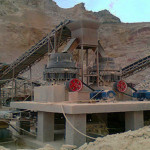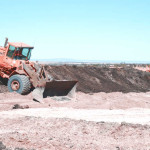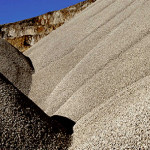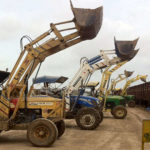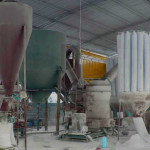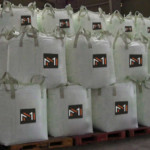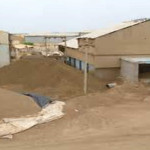Several decades ago when bentonite was introduced to the steel foundries of America as substitute for fire clay in sand bonding. It won rapid approval due to its more desirable combination of green & dry properties. Bentonite-bonded sands molded better and peeled from the castings better, and shakeut was improved, with less lumping of the sand.
The bentonites came from South Dakote & Wyoming in the Western part of the U.S.A., and when similar deposits were discovered in the South, the types were identified by the prefixes ‘Western’ & ‘Southern’. The southern bentonites, while having excellent properties for some types of molding, did not prove satisfactory in the steel foundry. For many years western proved so successful in the ‘Western’ and the suppliers consciously provided western bentonite.
At times we encountered periods of excessive sand problems, resulting in sand fragility, tears, scabs, etc. But these problems were usually attributed to unknown causes; mixes were changed, new and added, and eventually the trouble disappeared.
The author and his co-worker Gerry Grott set out to find the trouble, and among our many investigations and tests, we checked the PH of the molding sand. At this time we found it to be 5.6 , and we recalled that several years previous, during a period of excellent moldabiity and casting quality, the PH of the sand was around 8.5 to 9.0. At that time we gave no thought to this particular property; but now , being in trouble and with a sand mix with a 5.6 PH, we decided to add soda ash to the mix on one molding floor, raising the PH to 9.0. The trouble cleared up on this floor, but still remained on the others, so the next step was to treat all the molding sand. After this was done our troubles disappeared, and molders began to praise the workability of the sand.
We immediately set up a program of treating the sand mixes with additions of soda ash to control the PH, and set about to find out why our cure worked, so well, At the annual Technical and Operating Conference of the the steel Founders’ Society of America, we enclosed findings to our follow foundrymen.
Since the western bentonites are predominantly sodium-montmorilloonite clays, they possess a high PH, and any factor that lowers the PH has a detrimental effect on the bonding properties of the clay. We demonstrated this by plotting the change in viscosity of a 10% western bentonite slurry with the changes in PH (Fig.1). As the PH of the slurry was altered with sodium-carbonate, sodium-hydroxide mixtures (soda ash), or acentic acid, the slurry reached its most viscos point at about 9.5 pH. This same reaction takes place in the sand mix
Our sand troubles at the time may have been due to a souring of the sand from weather condition, to a development of a mild acid from the formation of carbon monoxide and dioxide of several of these conditions.
We found one shipment of bentonite that in itself only had a 5.6 to 5.8 pH, whereas it should be between 8.0 to 9.0. This low pH could be due to excess overburden in the clay, or from a diference in the bentonite composition due to its particular geological location within the western area.
With the disclosure of the importance of pH in the bentonite, for the steel foundries, the suppliers immediately began to watch this particular property more closely, and our subsequent shipments from all suppliers were more inform in pH factor. But as we had learned that this could be controlled with soda ash, so, also, could the producers likewise improve the pH factor of a poor bentonite, and hence improve the apparent quality of this product.
Although many of us were checking the pH factor of our bentonite shipments, some were still encountering occasional trouble. Were these other factors or qualities in these western bentonite that contributed to their successful use that were not being disclosed by pH factor ? Were these qualities measurable ? Were we buying doctored bentonite ?
Looking back over tests, we note Jack Caine, at an earlier date, introduced a settling test, where a small quantity of bentonite was dropped in a graduate of water. The slower the setting, the better the bentonite. This test was good as it indicated excess silt, colloidal activity, etc; but it was also affected by water conditions and personal interpretation of the test. The test provided us with the good indication of quality, but left us with no positive numerical index for specification or evaluation.
About 1955 the SFSA, with its Specification Committee and Research Committee, entered upon a project of developing tests for bentonite that would be based on t echnical factors which would indicate steel-foundry acceptability. These tests had to be fairly rapid, reproducible, reasonable in cost and acceptable to both producer and foundrymen.
Meeting wereheld with the producers. A project was set up at Massachusetts Institute of Technology, and several interested foun dries co-operated in attempt to work our and evaluate tests and standards.
In 1956 Howard Taylor introduced a modified liquid limit test on which both he and W.D. Emmett, of Los Angeles Steel Casting Company, reported in the 1956 conference.
That year we reported on a ‘plastic viscosity test’ used by some of the bentonite producers and which seemed to correlate well with molding characteristics. Both tests seemed to indicate similar qualities; however, mine was considerably more expensive, as the equipment cost over 500.
During the early plant of the W test semed to be considerable variation between laboratories, and this was traced chiefly to the difference in construction of the equipment handled by the various scientific apparatus supply houses and in the method of preparing the slurry. Howard Taylor set out to standardize the test cup construction, the grooving blace and the slurry mixing method, or devic.
In the meantime, C.W.Briggs, R.H.Frank, C.B.Williams and myself, representing various committees of SFSA made a trip that encompassed visits to almost all of the mines and plants of the various U.S. producers of western bentonite for steel foundry use in order to better acquaint ourselves with their methods and problems. A tentative specification was finally prepared, based on facts.
References
1. V.E. Zang and G.J. Grott, ‘Casting Quality as related to pH Value of Molding sands, ‘Foundry, March,1954.
2. Steel Foundries ‘Society of American-Tentative Specification for Western Bentonite, SFSA designation : 13 T.
3. The Significance of Liquid Limit in Evaluating Steel Foundry Bentonite. ‘Steel Foundries’ Society of American Report no. 40, December,1957.
4. Investigation on the effect of heat on the bonding properties of various bentonite’s by Franza Holfman, Modern Castings, July – 1958, P. 31 – 37.

